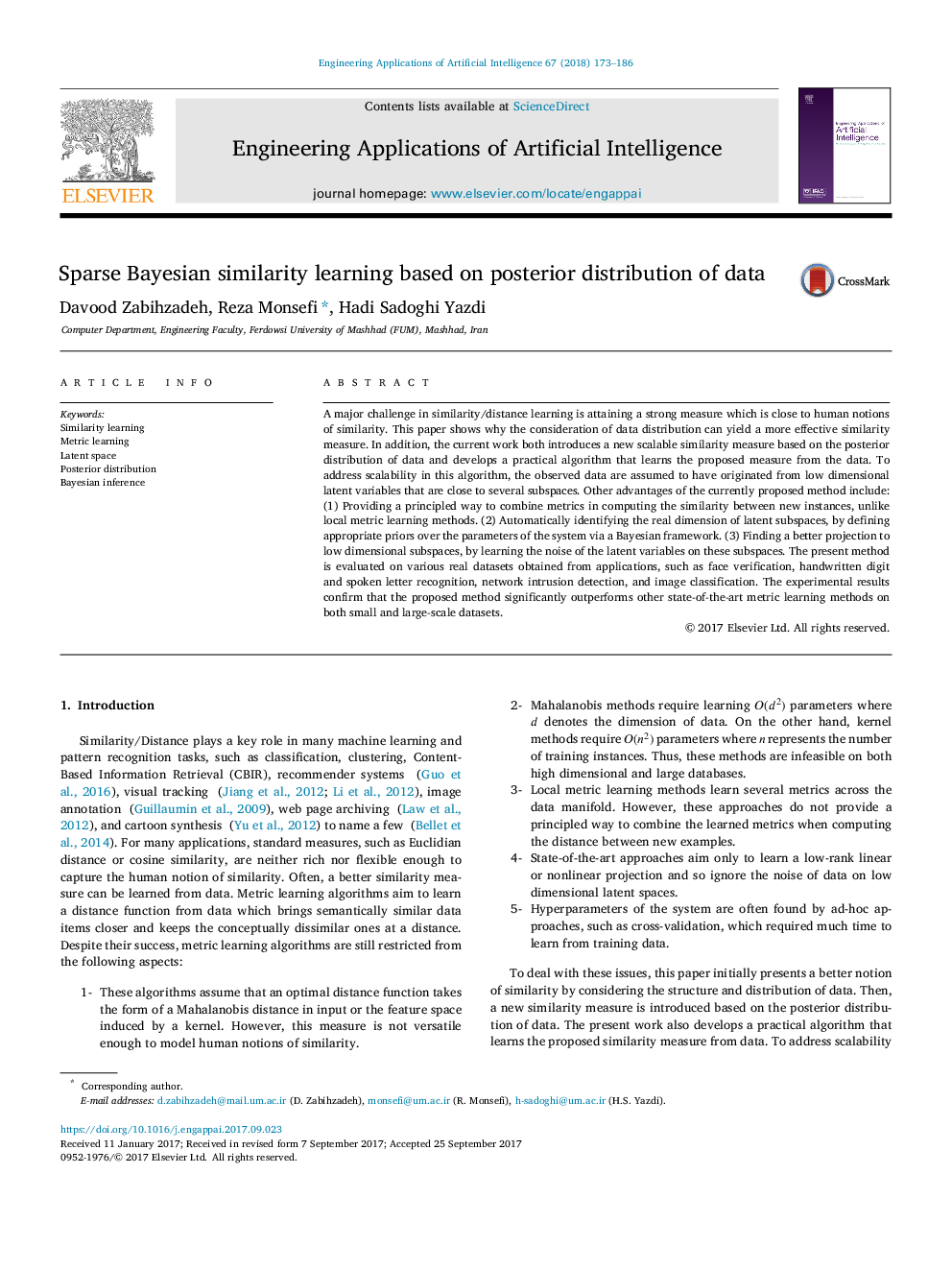| کد مقاله | کد نشریه | سال انتشار | مقاله انگلیسی | نسخه تمام متن |
|---|---|---|---|---|
| 6854294 | 1437411 | 2018 | 14 صفحه PDF | دانلود رایگان |
عنوان انگلیسی مقاله ISI
Sparse Bayesian similarity learning based on posterior distribution of data
ترجمه فارسی عنوان
یادگیری تقریبی بی نظیر بر پایه توزیع خلفی داده ها
دانلود مقاله + سفارش ترجمه
دانلود مقاله ISI انگلیسی
رایگان برای ایرانیان
کلمات کلیدی
یادگیری شباهت، یادگیری متریک، فضای خالی توزیع پشتی، استنتاج بیزی،
ترجمه چکیده
یک چالش عمده در تشابه / آموزش از راه دور، دستیابی به یک معیار قوی است که نزدیک به مفاهیم انسان از شباهت است. این مقاله نشان می دهد که چرا توجه به توزیع داده ها می تواند یک معیار شباهت بیشتر باشد. علاوه بر این، کار فعلی هر دو روش اندازه گیری شباهت های مقیاس پذیر جدید را براساس توزیع خلفی داده ها معرفی می کند و یک الگوریتم عملی ارائه می دهد که اندازه گیری پیشنهادی را از داده ها می آموزد. به منظور مقیاس پذیری در این الگوریتم، داده های مشاهده شده فرض می شود که از متغیرهای پنهان کم بعدی که نزدیک به چندین زیر فضای هستند، حاصل می شود. مزایای دیگر روش پیشنهادی در حال حاضر عبارتند از: (1) ارائه یک روش اصولی برای ترکیب معیارهای در محاسبه شباهت بین نمونه های جدید، بر خلاف روش های یادگیری محلی متریک. (2) به طور خودکار شناسایی ابعاد واقعی زیرپوشه های پنهان، با تعریف صحیح مناسب بر روی پارامترهای سیستم از طریق یک چارچوب بیزی. (3) یافتن یک طرح بهتر برای زیربناهای بعدی کم، با یادگیری سر و صدا از متغیرهای پنهان در این زیرموها. روش حاضر در مجموعه داده های مختلفی از برنامه های کاربردی مانند ارزیابی چهره، رقم دست نوشته و تشخیص حرف، تشخیص نفوذ شبکه و طبقه بندی تصویر ارزیابی می شود. نتایج تجربی تأیید می کنند که روش پیشنهادی از دیگر روش های یادگیری متریک در هر دو حالت کوچک و بزرگ استفاده می کند.
موضوعات مرتبط
مهندسی و علوم پایه
مهندسی کامپیوتر
هوش مصنوعی
چکیده انگلیسی
A major challenge in similarity/distance learning is attaining a strong measure which is close to human notions of similarity. This paper shows why the consideration of data distribution can yield a more effective similarity measure. In addition, the current work both introduces a new scalable similarity measure based on the posterior distribution of data and develops a practical algorithm that learns the proposed measure from the data. To address scalability in this algorithm, the observed data are assumed to have originated from low dimensional latent variables that are close to several subspaces. Other advantages of the currently proposed method include: (1) Providing a principled way to combine metrics in computing the similarity between new instances, unlike local metric learning methods. (2) Automatically identifying the real dimension of latent subspaces, by defining appropriate priors over the parameters of the system via a Bayesian framework. (3) Finding a better projection to low dimensional subspaces, by learning the noise of the latent variables on these subspaces. The present method is evaluated on various real datasets obtained from applications, such as face verification, handwritten digit and spoken letter recognition, network intrusion detection, and image classification. The experimental results confirm that the proposed method significantly outperforms other state-of-the-art metric learning methods on both small and large-scale datasets.
ناشر
Database: Elsevier - ScienceDirect (ساینس دایرکت)
Journal: Engineering Applications of Artificial Intelligence - Volume 67, January 2018, Pages 173-186
Journal: Engineering Applications of Artificial Intelligence - Volume 67, January 2018, Pages 173-186
نویسندگان
Davood Zabihzadeh, Reza Monsefi, Hadi Sadoghi Yazdi,
